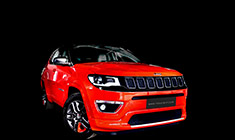News
2025 BMW X3 Review: Observations after a day of driving
Out on the highway, the X3 diesel munches miles effortlessly. With loads of torque on offer, the engine feels relaxed on the highway. You’ll enjoy cruising comfortably at triple-digit speeds during road trips.
Driving the 2.0-litre diesel AT
We got to drive the xDrive 20d version of the X3, which gets a 2.0-litre, inline 4-cylinder diesel engine that makes 194 BHP @ 4,000 rpm and 400 Nm @ 1,500-2,750 rpm. It’s mated to an 8-speed automatic transmission:

The B47 engine that we saw in the previous generation has been carried over to the new X3 as well. This is a gem of an engine and is popular for its smoothness and efficiency. It also gets a 48V electrical system mild hybrid tech for a better lower end and efficiency. How times have changed! We don’t get to test diesel cars very often. After pressing the start-stop button on the centre console, the engine comes to life. It’s a fairly silent affair, and there’s no diesel rattle that you hear inside the cabin.
Start driving in the city and you’ll notice that the engine’s main characteristics are smoothness and refinement. The power delivery is linear and there’s no unnecessary spike. The throttle response is good and you can modulate the input with ease. The gearbox is well calibrated and the shifts are barely perceptible at slow speeds. Even when driving at part throttle, the gearbox manages to stay in the right gear most of the time. Ask for more power for a quick overtake and the gearbox doesn’t hesitate to drop down some gears and give you a boost. There’s enough power on tap for Indian road conditions. You can get by just fine.
Out on the highway, the X3 diesel munches miles effortlessly. With loads of torque on offer, the engine feels relaxed on the highway. You’ll enjoy cruising comfortably at triple-digit speeds during road trips. The engine delivers power in a linear way and revs freely. Overtakes are pretty easy. You can get past most cars without going pedal to the metal. If you want to go full throttle, there’s also a Sport Boost function in which you can pull on the left paddle shifter to get a surge of power for 10 seconds. Mind you that the 20d engine is not blisteringly fast, but it’s a quick performer. The X3 diesel will accelerate to 100 km/h from a standstill in 7.7 seconds. Overall, this is a tried and tested engine with a good track record for reliability.
The 8-speed automatic gearbox is tuned nicely for both the city and the highway. We found no complaints with the gearbox, even on kickdown. The response time is fair and the gearbox always seems to find the right gear for every driving condition. You also get paddle shifters if you want to take control of the gears manually.
If you want to change the driving characteristics, there are 3 driving modes to choose from. You have to press a button on the centre console and then choose the mode from the menu that pops up on the touchscreen. Parameters that can be changed with driving modes are – engine map, suspension and steering.
Efficient – This is the most comfortable setting. The engine map isn’t really dulled down, but it’s in a comfortable setting. You can drive in the efficient mode in the city as well as on the highway.
Sport – On selecting this mode, the throttle response is sharper, the suspension is a bit stiffer and the steering gets heavier. You can go further into settings and select Sport Plus for the drivetrain and even switch off the traction control system.
Personal – In this mode, you can customise the different characteristics as per your liking.
Noise, Vibration & Harshness (NVH)
As mentioned earlier, the overall refinement is good. Inside the cabin, the engine doesn’t sound loud while driving. At high revs, the engine is heard inside the cabin, but it doesn’t sound strained. The engine is noticeably loud on the outside, but that’s pretty common with diesel units. The road noise and wind noise are well controlled, even at 100-120 km/h.

Mileage & Fuel economy
The diesel engine makes the X3 a comfortable cruiser. It also has a track record of delivering good fuel efficiency. The claimed FE number for the 20d is 17.86 km/l. We’ll leave the real-world efficiency numbers to Team-BHP ownership reports.

Suspension

Ride Comfort
We’ve seen the recent BMWs go for a softer suspension setup and the same is the case for the new X3 as well. The ride comfort is good at low speeds and the car doesn’t feel busy. The bump absorption is good and suits the Indian road conditions. You still have to be careful over large potholes, but small potholes are taken with ease. The suspension works silently and most of the owners will appreciate this suspension tune. The X3 also gets adaptive suspension as standard, and there are 2 modes that you can choose from – Comfort and Sport. The Comfort mode works best for day-to-day driving. BMW has also ditched the run-flat tyres and gone for tubeless rubber. This further smoothens out those small irregularities on the roads.
Handling & Dynamics
Straight-line stability on the highway is great and the car masks speed very well. You can do triple-digit speeds all day long and the passengers won’t even feel it. You can feel expansion joints in the cabin, but they won’t unsettle the car. Switching to Sport mode will stiffen things up and add that extra bit of stability. Also, it will help you carry some more speed into the corners, where the X3 manages to hold its line well. Body roll is well-controlled for an SUV of its size, too. The grip from the 245/50 R19 Nexen N’Fera tyres is good, and the all-wheel drive system makes sure that you stay on the road. The car doesn’t feel nervous in quick direction changes and you can enjoy the car in the ghats. The overall balance of the car feels good for the amount of power on offer.
Steering
The electric power steering is light to use in the city. On the highways, it weighs up nicely and you can switch to the Sport mode setting for added heft. The steering feels direct and relays good feedback, but we wish there was a bit more heft for added confidence in corners.
Braking
The all-wheel disc brake setup performs very well in emergency braking situations and the car doesn’t lose its composure. Even the pedal feels good to operate and it’s easy to modulate the braking input as well. The X3 comes with certain ADAS features, including front collision warning with brake intervention.
Continue reading the discussion on the BMW X3Â on our forum.
Â






















